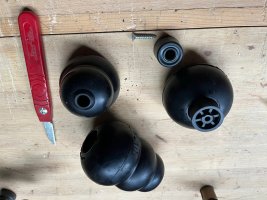@DaveOM
Good that you are getting some enjoyment from tactile, here are some points I see but do believe you can improve the immersion you are getting. Are you interested in that, well you should be, right?
Tactile Basics:
If we trace where the primary energy from the transducers which are mounted on the brackets that connect to the isolators can flow. Then we can be certain that the first point of travel/flow the vibrations have are...
1) Into the isolation springs and to the floor
2) Along the main lengths of the frame of the rig
3) Across the horizontal connections of the rig's frame connected to the main lengths
Yes, their energy will also go up into the seat/pedal sections but the approach of this concept is flawed/counter-productive based on 1,2,3 above. It places units in representative positions for wheels/suspension bringing limited/questionable benefits, over and above any priority in achieving better efficiency and performance for felt effects being generated.
As an approach, it also does nothing to go beyond the "performance limitations" of what is a fairly average budget model, yet $750 is quite a lot of money. While I know the springs/isolation performs quite well. Just my views, but, too much of the budget for this concept is within the springs/isolation.
I dont get it, isolation is usually about reducing the vibrations going into the floor or helping maintain the tactile energy within the isolated object. In this case the whole rig. So placing the transducer on top of the isolation, makes it easier for its primary energy/detail in its output go through the isolator into the floor.
As disclosed and proven by several others that have had 4-way installations in the past. Improvements are possible from more direct, closer proximity installations of transducers that also offers less mass/weight which we achieve by applying isolated pedal/seat sections instead.
The additional "bobbins" you are using for seat isolation are quite basic. They have about 1/2 inch of neoprene rubber in between the two (male/female) threads. In your images, it appears the rubber isolator is not in proper contact with the frame of your rig, as the bolt seems to have them raised.
Conflict:
The two rear transducer units generated vibrations for your seat, now have to go through/past these additional "isolation bobbins" you have installed.
It appears that you are trying to isolate the seat from the rig for Earthquake Q1 to help maintain its vibrations within the seat. You are then reducing/limiting the vibrations from your rear corner units going into the seat.
Achieve more detail and better resulting tactile with lower amp output if you do the following:
1) Seek to make/buy better isolators for the seat but consider giving these a stable/full contact support beneath, not just hanging over or balanced on a 45mm profile edge. Perhaps use corner brackets each side to offer a wider support for the 64mm dia:
Possibilities =
Clark Ti 200 120kg model (quite firm)
Clark Ti 100 / Penn Elcom 64mm dia
As documented on these forums by myself in the past, insert a bobbin like the ones you have between top/bottom 64mm isolators for an improved and affordable solution.
Example:

You can add, neoprene and metal washers on the inside to help increase the height to help with the internal bobbins compression. You can have the bobbin replicate the role of a spring.

An alternative is to consider different lengths/thicknesses of springs instead of the bobbin that fit but these are more expensive.
2. More direct installation to seat/pedals:
What you or others, seriously need to consider is having the transducers at the rear connected to some form of plate that connects directly to the sides of the seat frame or seat risers.
This way you have the BEST of the transducer's detail/energy going DIRECTLY into the seat as the PRIMARY contact surface/object. This combined with your current spring/isolation will still act as (secondary isolation) from vibes going into the floor.
I hope some of you will try this and report back but also, still nobody has shown or said anything about the effects that come with this $750 option.














